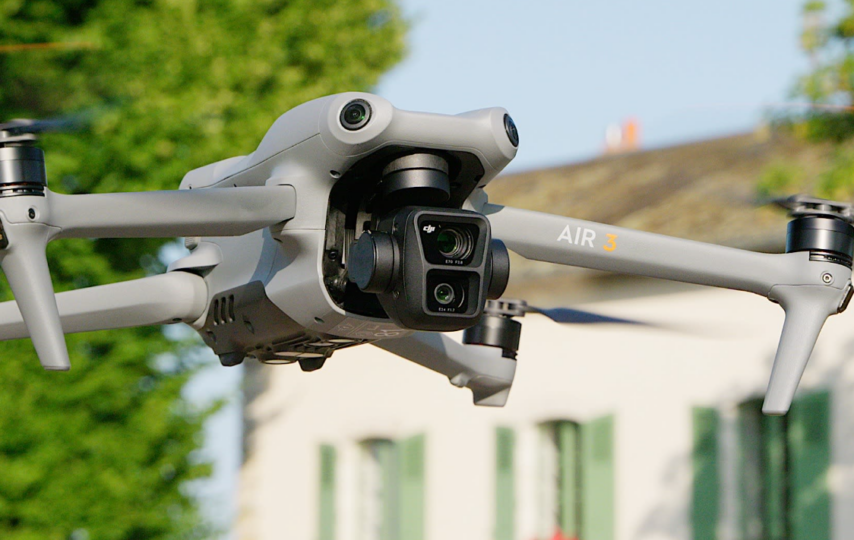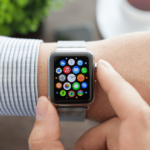DJI’s Air drone series strikes a sweet spot between portability and image quality. It’s a great pick for folks who want a compact drone but still crave high-quality shots. Two years after the release of the DJI Air 2S, here comes the DJI Air 3. This time around, the Air 3 boasts a 48MP dual main camera system, 46-minute flight time, DJI O4 image transmission, and comprehensive obstacle avoidance. Notably, it features a new 3x medium-to-long zoom lens as part of its main camera setup, letting users capture that “compressed” look and making it easier to shoot subjects, especially people, while on the go.
Imaging: 48MP Dual Main Cameras for More Creative Freedom
The most noticeable upgrade on the DJI Air 3 is definitely its imaging system. While the DJI Air 2S comes with the older-gen 1-inch back-illuminated CMOS sensor with support for 20MP and an f/2.8 aperture, the Air 3 rocks a dual 48MP main camera system. This means you’ve got way more flexibility when it comes to getting creative with your shots.
The DJI Air 3 has both a wide-angle camera and a 3x medium-to-long zoom camera. Switching between them is a breeze—just hit the 1x or 3x button on the user interface. Easy peasy.
Wide-Angle Camera: The wide-angle camera is decked out with a brand-new 1/1.3-inch stacked CMOS sensor design. It’s got a whopping 48 million effective pixels, an f/1.7 aperture, and a 24mm equivalent focal length. The image quality you get out of this is even better than what the one-inch sensor on the Air 2S delivers, especially when shooting at night. That’s not too surprising since the sensor sizes aren’t all that different, and the f/1.7 aperture lets in a lot more light—perfect for those nighttime shots.
Medium-to-Long Zoom Camera: This one also uses a 1/1.3-inch CMOS sensor with 48 million effective pixels, but the aperture here is f/2.8 with a 70mm equivalent focal length. Its specs line up with what you’ll find on the DJI Mavic 3 Pro.
Video Recording: When it comes to video, both cameras on the DJI Air 3 support up to 4K 60P specs and HDR recording. They also let you capture slow-mo in 4K 100P and 1080P 200P (you can choose to stick with the highest 4K resolution if you want). All of this is uncropped video, which is a noticeable step up from the Air 2S that only offered cropped 4K 60P video and had no HDR support.
Vertical Video: Aside from the usual landscape mode, the DJI Air 3 also lets you shoot in 2.7K 60P vertical video. It’s not because the lens rotates or anything, it just crops a portion of the frame for the recording. But hey, if you’re into short-form video content, these specs should be more than enough for you.
Obstacle Avoidance: The First in the Air and Mini Series to Offer Full-On Obstacle Avoidance
Obstacle avoidance is super key when you’re out shooting. It makes your drone flight safer and more reliable. The DJI Air 3 is the first in the Air and Mini series to offer all-around obstacle avoidance. It’s packed with APAS 5.0 tech, putting it on par with the Mavic 3 series. So whether you’re talking about dodging obstacles or the whole smart-follow experience, this drone’s got you covered for pretty much any environment or shooting need you can think of.
The DJI Air 3 has four fisheye cameras on its head and tail end. These give complete coverage of the side and top views. But take note—there’s no obstacle avoidance camera on the top of the drone. This makes us think the Air 3 probably has a souped-up obstacle avoidance algorithm. On the underbelly, you’ve still got the wide-angle camera, ToF (Time-of-Flight) distance sensor, and a supplementary light. What’s different from the Air 2S is that the ToF sensor has been moved from near the tail to the centre of the bottom.
Image Transmission: Debut of DJI O4 and a New Remote
Along with the launch of the Air 3, DJI’s O4 image transmission tech is making its first appearance in DJI drones. Just for a quick comparison: the Air 2S had DJI O3, supporting a max distance of 12 km for image transmission (according to FCC standards; for SRRC/CE/MIC, it’s 8 km max). The Mavic 3 series has DJI O3+, going up to 15 km (again, FCC standards; SRRC/CE/MIC max out at 8 km). But now, this shiny new Air 3 comes loaded with DJI O4, pushing the limits to an impressive 20 km for image transmission (that’s according to FCC; for SRRC/CE/MIC, you’re looking at a max of 10 km).
In terms of the image transmission quality, the Air 2S offered up to 1080P at 30fps for its image transmission. The Mavic 3 series steps it up a notch with 1080P at 60fps. Now, the Air 3 also rocks the same 1080P at 60fps. So, when it comes to how well it handles image transmission, the Air 3 is basically on the same level as the Mavic 3 series.
Battery Life: 46 Minutes on a Single Battery, Plenty of Time for Aerial Shots
On the battery life front, the DJI Air 3 has gotten a nice little boost. The Air 2S maxed out at 31 minutes, but the Air 3 takes it up a notch to 46 minutes. That puts it in the same league as the Mavic 3 series and the Mini 3 Pro. So yeah, you’ve got plenty of airtime for capturing those awesome views.
Because the flight time’s gone up, the DJI Air 3’s battery has obviously gotten bigger, nearly reaching the size of the Mavic 3 series’ smart flight batteries. So what’s the big deal with 46 minutes of flight time? Well, if you knock off about 15 minutes for takeoff, adjustments, and heading back, you’ve still got a solid 30 minutes for aerial photography. That’s enough juice to shoot some lengthy scenes or even some time-lapse footage.
The Almost-Flagship Drone That’s Perfect for Creative Shots and People Pics
And that wraps up our review and intro of the DJI Air 3. With all its upgrades, it’s not just giving users a wider range of aerial shots, but also an overall better experience in terms of flight performance, battery life, and image transmission. The big selling point of the Air 3, aside from its dual main cameras, has to be its 3x mid-to-long zoom lens. This isn’t just offering a fresh perspective; it’s particularly good for capturing people, adding a whole new level of awesomeness to portraits and other people shots. With its 70mm equivalent focal length, you’ll get larger, more compressed shots of people, making group selfies on your journeys look even better. That’s why the Air 3 is being hailed as the “best drone for shooting people” in the almost-flagship category. So, if you’re in the market for a drone that you’d actually want to take out and about, and you’ve got some pretty specific ideas about image quality, the DJI Air 3 is definitely worth considering.








